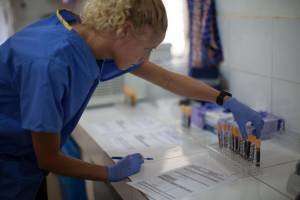The fight against neglected poverty-related diseases can only be won jointly. Photo of a vaccination lab in Guinea. Credit: WHO/Sean Hawkey
Ebola, malaria, tuberculosis: These are the three best known poverty-related diseases affecting millions of people. They are predominantly encountered in poor countries due to the inadequate medical care there. Another reason is that the development of the corresponding drugs in industrialized countries is far from being economically attractive. New, non-profit types of cooperation for drug development, open innovation processes, and the expansion of clinical centers and regulatory bodies in the regions affected can strengthen research and product development. These options are the result of a study made by the Office of Technology Assessment with the German Bundestag (TAB) operated by Karlsruhe Institute of Technology (KIT).
The study made on behalf of the German parliament represents the so far most comprehensive analysis of medical innovations for developing countries and the role of Germany in this respect. "The medical innovation process in industrialized countries is largely commercialized, which means that highly expensive product development has to be refinanced from the costs of the medicine. As a result, new drugs mostly are developed for globally occurring diseases only and are very expensive over years – unaffordable for poor countries," says Katrin Gerlinger, who coordinated this study of TAB. Moreover, product development is insufficient for diseases that occur almost exclusively in countries of the global South.
Different actors, from non-governmental organizations to global health experts to private foundations to pharmacological associations, have been discussing, partly very controversially, whether commercial drug research is the core of the problem and whether market mechanisms are to be supplemented or replaced. As an example, Katrin Gerlinger mentions the dispute concerning patents and trade agreements. "For some, they are drivers of product development. For others, they are the cause and aggravators of the problem," Gerlinger says. In order not to get stuck between these opposed opinions, the TAB, together with several expert teams, examined the entire innovation process, from publicly funded fundamental research to mostly commercialized product development to approval and monitoring during application. "We need a higher commitment at various points," Gerlinger says.
Open Innovation Gains Importance
According to the study, open innovation initiatives, such as those launched in the US and the UK, are rather positive: Public institutions and pharmaceutical companies open their drug libraries and laboratories for specific research activities relating to selected neglected diseases. They manage and share patents and make data and documentation of clinical trials available for the joint further development of active substances. "German institutions still are very cautious in this respect," Katrin Gerlinger says. To make use of the big potential of a joint battle against neglected diseases, more self-initiative of public and private research institutions and a clearer commitment to research policy would be desirable, she adds.
The technology assessment expert considers another option for German politics to be the expansion of clinical centers and regulatory bodies in the regions affected, because studies proving the effectiveness of new substances can only be carried out where the diseases are rampant. To create the highly qualified jobs required for this purpose in African countries in particular and to stop the brain drain, i.e. the emigration of qualified staff, development, health, and research policy partners should pursue a joint strategy.
In addition, parliament should discuss incentives to promote private-sector involvement, such as tax credits or success-based remunerations. Moreover, visibility of the commitment of public institutions should be enhanced in Germany.
According to Professor Armin Grunwald, Head of the TAB and of the Institute for Technology Assessment and Systems Analysis (ITAS) of KIT, the study underlines that observations in practice and theoretical reflections generate a joint value in technology assessment. In the present case, technology assessment provides policy makers, science, and industry with a solid information base for better orientation of the medical and technical innovation system. "If political discussion of the action options developed by the new Bundestag contributes to further medical innovations, I would be very pleased," he says.
Provided by Karlsruhe Institute of Technology


















